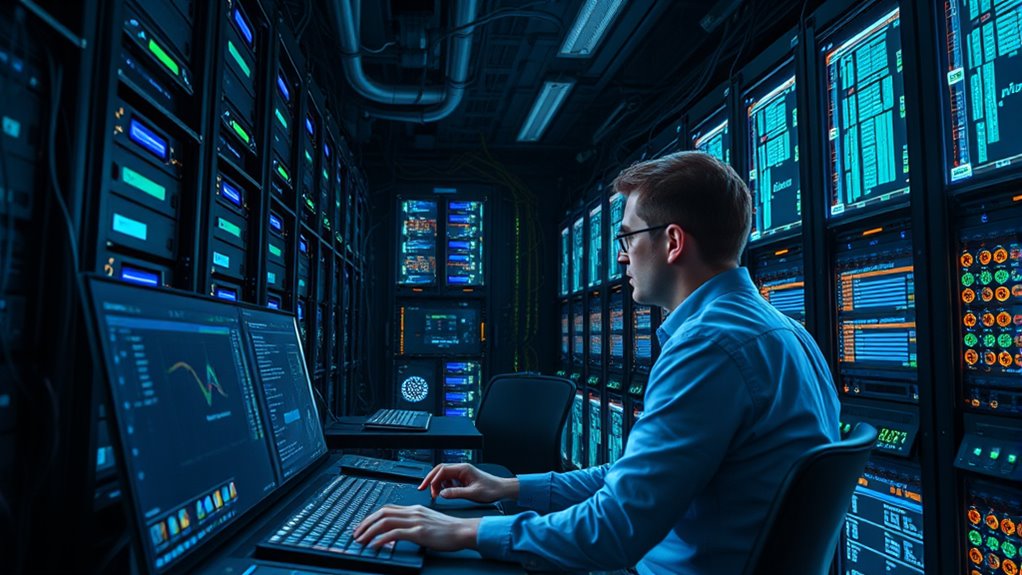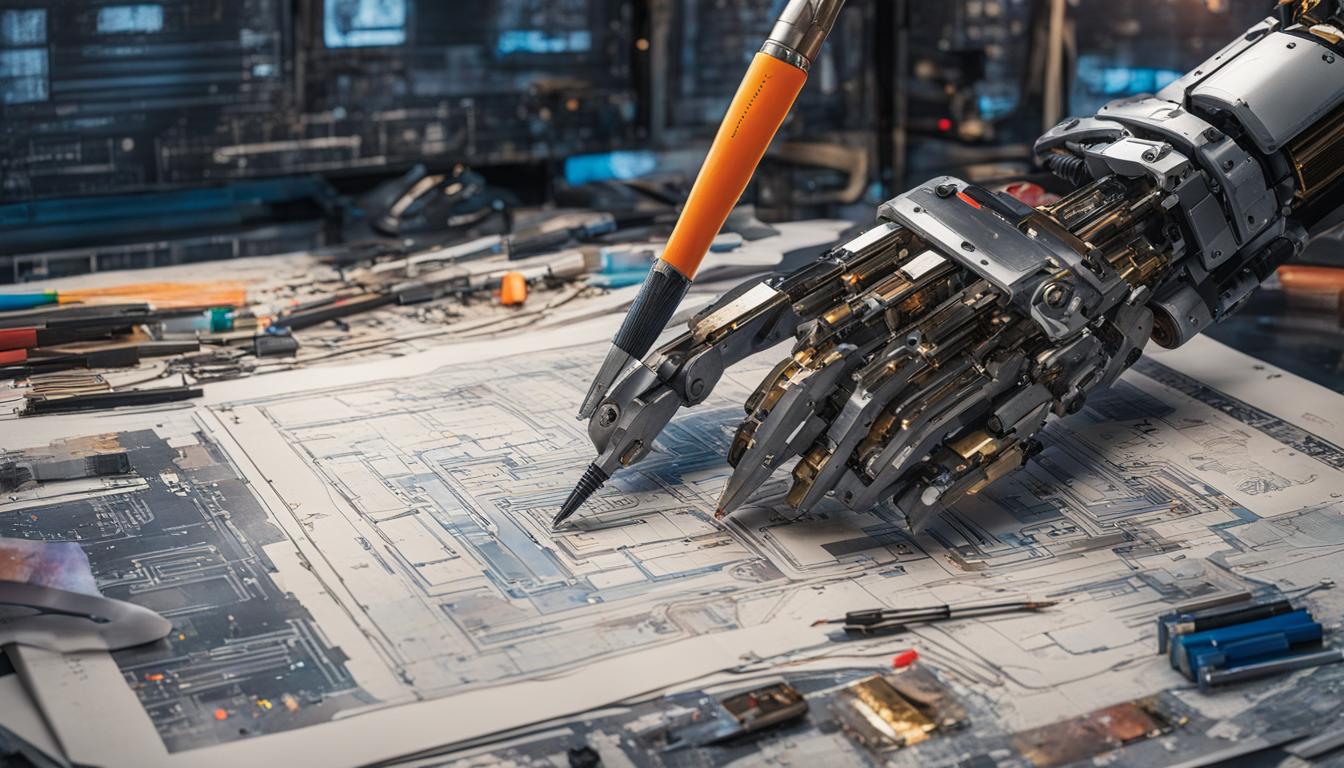As OpenAI’s energy demands skyrocket with high-powered models like GPT-5, Sam Altman is leading a global effort to find sustainable, energy-efficient solutions. The models now require massive electricity, often comparable to large cities, which strains power grids and raises environmental concerns. Despite improvements, energy use continues to grow with model complexity, pushing industry leaders to innovate quickly. Stay with us to learn how this worldwide push could reshape AI’s future and its ecological footprint.
Key Takeaways
- OpenAI’s increasing energy demands from models like GPT-5 have prompted industry leaders to seek sustainable, energy-efficient AI solutions.
- Sam Altman and other executives are initiating a global tech race to develop greener AI infrastructure amid rising power consumption.
- The surge in AI model complexity and usage is straining data centers and power grids worldwide, highlighting the need for innovation.
- Industry efforts focus on transparency, hardware improvements, and infrastructure investments to reduce AI’s environmental impact.
- The growing energy footprint of AI emphasizes the urgency for sustainable policies and technological advancements in the industry.

As artificial intelligence models like OpenAI’s GPT series grow more advanced, their power demands are reaching unprecedented levels. You might not realize it, but each interaction with a model like GPT-5 can consume significant energy—around 18 watt-hours per query, with some responses pulling up to 40 Wh. To put that into perspective, GPT-4 queries average just 0.3 to 0.34 Wh, meaning newer models are much more energy-hungry despite efficiency improvements. OpenAI doesn’t officially disclose detailed energy data for GPT-5, but estimates based on academic research suggest that GPT-5 could consume up to 45 GWh daily—about 8.6 times more than GPT-4. This escalating power use is creating a ripple effect on a global scale, pushing data centers to their limits. These centers, heavily reliant on GPUs, now consume more electricity than entire nations like South Africa or Indonesia. You need to understand that AI-driven energy demand is projected to almost double from 260 TWh in 2024 to 500 TWh by 2027, threatening to strain existing power grids, especially during peak hours in major cities. OpenAI’s infrastructure alone is estimated to draw between 10 and 17 GW, akin to the power consumption of large metropolitan areas such as New York City. Such massive energy requirements demand substantial infrastructure investments, including multiple nuclear reactors, which raises environmental concerns. High energy use results in significant carbon emissions, prompting calls for greater transparency and efficiency improvements. While some progress has been made—like a 44-fold reduction in emissions per query over a year—there’s still a long way to go. Hardware advances have helped reduce per-query energy, but increasing model complexity and size continue to drive up overall power consumption. GPU-based data centers, due to their computational intensity, remain primary culprits of AI’s electricity footprint. Public and industry efforts to disclose energy metrics are inconsistent; companies like Google and OpenAI provide some data, but transparency remains limited. This situation has led governments to regulate data center expansion, with places like Singapore limiting capacity approvals. The growing energy demands of AI models have sparked a global tech sprint, with Sam Altman and industry leaders racing to develop more sustainable, energy-efficient solutions—an urgent challenge that combines technological innovation with environmental responsibility. Additionally, dog names can be used as a fun way to personalize and bring character to AI-driven applications, making interactions more engaging and relatable.
Frequently Asked Questions
How Does Openai Plan to Reduce Its Energy Consumption Long-Term?
You can see that OpenAI plans to reduce its energy consumption long-term by continuously improving hardware and software efficiency. They’re adopting advanced GPU architectures, optimizing algorithms, and shrinking model sizes to cut energy needs. Additionally, they’re shifting to renewable energy sources, enhancing data center operations, and promoting transparency. Collaborating with industry groups and researchers helps set sustainability benchmarks, ensuring that AI development becomes more environmentally friendly over time.
What Renewable Energy Sources Is Openai Exploring for Its Data Centers?
You see open fields of shining solar panels and swirling wind turbines as OpenAI explores solar and wind energy for its data centers. These sources capture the sun’s rays and wind’s gusts to power massive servers sustainably. They’re also considering emerging options like green hydrogen, creating a future where clean, flexible energy fuels AI advancements. This approach reduces reliance on fossil fuels and supports long-term environmental goals.
How Does Openai’s Power Usage Compare to Other Tech Giants?
You see, OpenAI’s power usage per query is higher than Google’s Gemini, which uses about 0.24 watt-hours, compared to OpenAI’s 0.34. However, OpenAI’s total energy demands are significant, with daily power consumption nearly 40 million kWh. While they’re making strides in efficiency, their inference loads still heavily impact energy resources. Other giants like NVIDIA and Microsoft also face rising energy needs, but OpenAI’s focus on scaling AI increases its share of global power consumption.
Are There Any Innovations in AI That Could Lower Energy Requirements?
Yes, innovations like optimizing algorithms, streamlining models, and developing more efficient hardware can substantially lower AI energy requirements. You should also look into AI-driven energy management systems that enhance grid efficiency, predictive maintenance to cut waste, and integrating AI with renewable energy sources. These advancements help reduce overall energy consumption, making AI more sustainable and environmentally friendly while maintaining high performance.
What Role Do Government Policies Play in Managing Openai’s Energy Impact?
Government policies play a vital role in managing OpenAI’s energy impact by enforcing transparency, setting efficiency standards, and encouraging sustainable infrastructure. They require companies to disclose energy use, promote renewable energy integration, and provide incentives for green tech investments. These policies help you monitor environmental footprints, prevent grid overloads, and align AI growth with climate goals, ensuring responsible development while reducing overall energy consumption and environmental harm.
Conclusion
As you watch OpenAI’s power demands soar like a rocket heading to the stars, it’s clear the race for AI dominance is more than just a technological battle—it’s a global sprint fueled by energy and ambition. You’re witnessing a landscape where innovation blazes forward, lighting up the future, but also casting shadows over sustainability. As the world chases this luminous frontier, you realize that balancing progress with responsibility is the true challenge ahead, like walking a tightrope over a blazing inferno.











